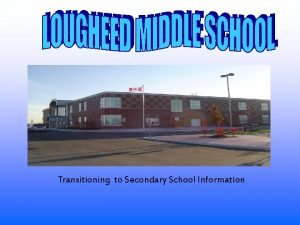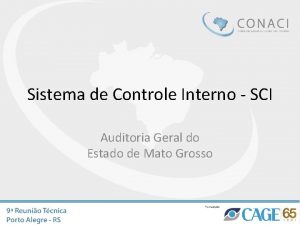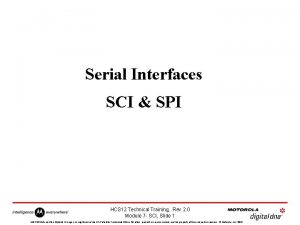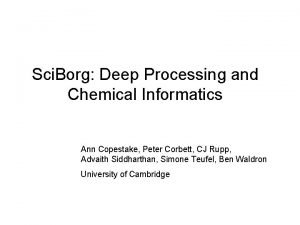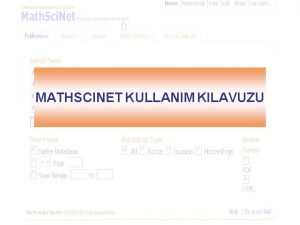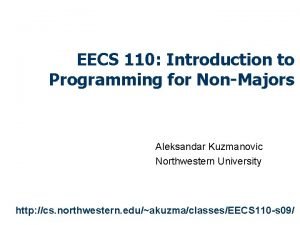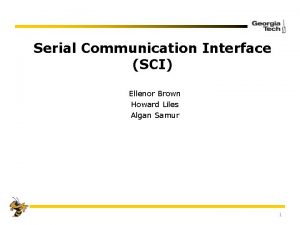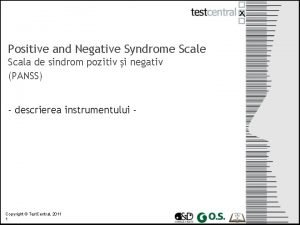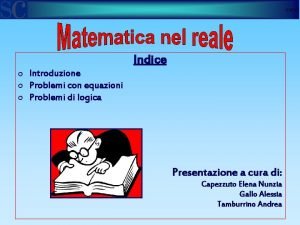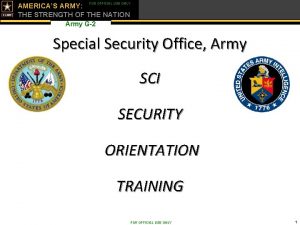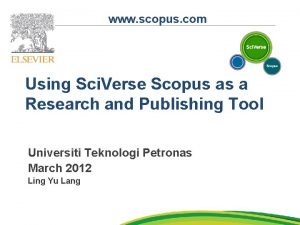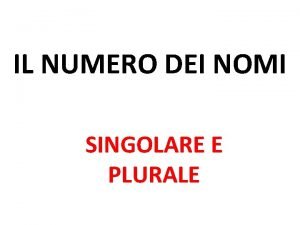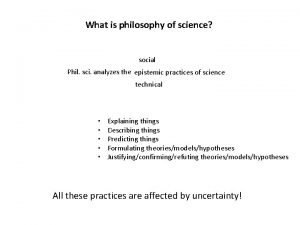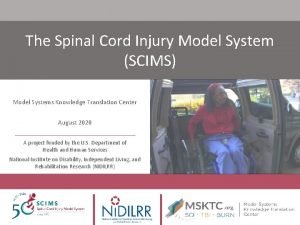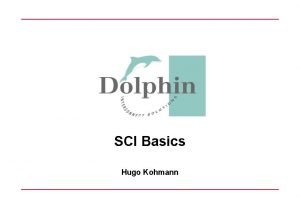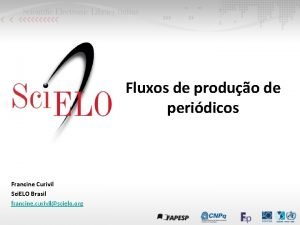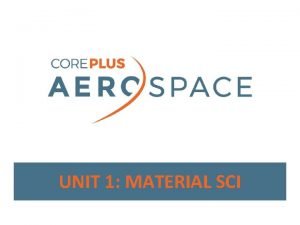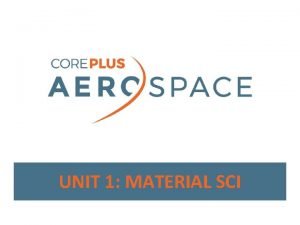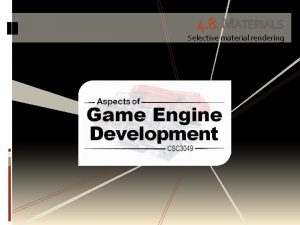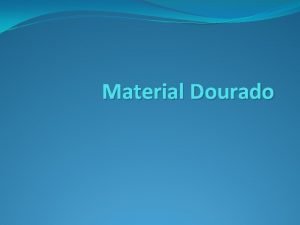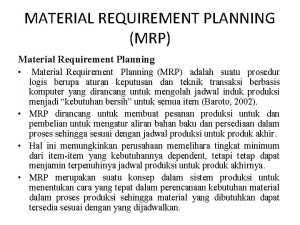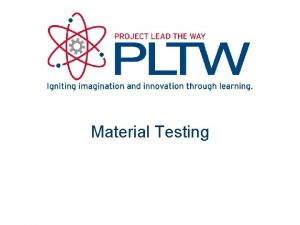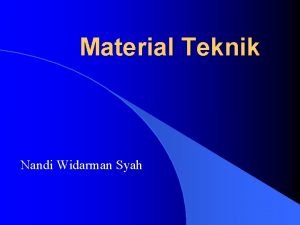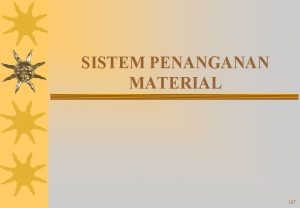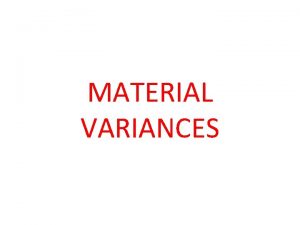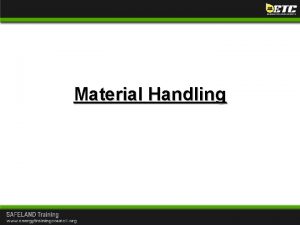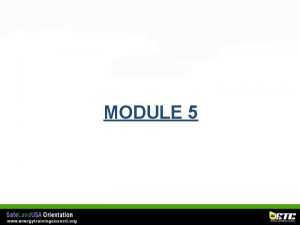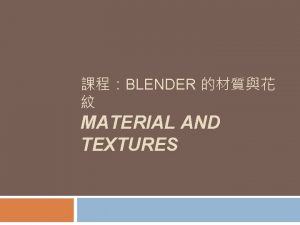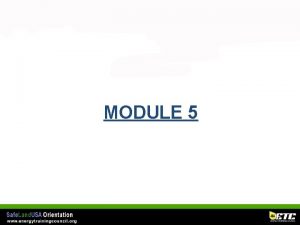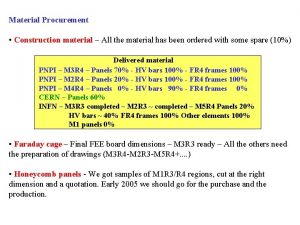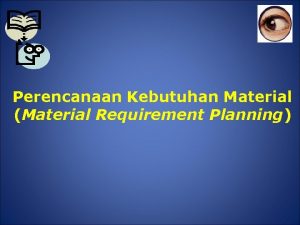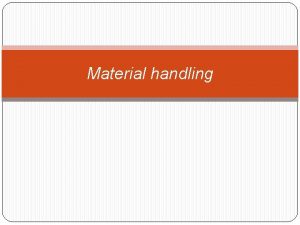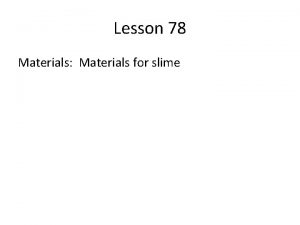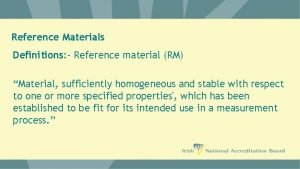UNIT 1 MATERIAL SCI Unit 1 Materials LESSON










































- Slides: 42

UNIT 1: MATERIAL SCI

Unit 1: Materials LESSON 3: PROPERTIES OF MATERIALS MODULE 1: PHYSICAL, MECHANICAL AND CHEMICAL PROPERTIES Special thanks to Andy Nydam and Debbie Goodwin

COURSE INFORMATION Unit 1: Materials • Lesson 1: Classification of Materials • Lesson 2: Crystals • Lesson 3: Properties of Materials – Module 1: Physical, Mechanical and Chemical Properties – Module 2: Corrosion • Lesson 4: Intro to Composites Course Description: • This lesson introduces and defines the properties of materials. Students select materials suitable for making a particular object based on their physical and chemical characteristics relating these to the mechanical properties and design consideration. The emphasis on recording and interpreting observations is expanded.

OBJECTIVES 1 After completing this course you will be able to: • List several common materials used in the design and construction of structures • Define simple properties of materials, such as strength, flexibility, transparency • Select suitable materials for making a particular object based on their properties • Explain the advantages and disadvantages of common materials used in engineering structures

OBJECTIVES 2 • Distinguish between chemical and physical properties of a material • Define thermal expansion • Evaluate the effects of thermal expansion on design considerations • Describe the response to force or stress using the terms: workability (malleability and ductility), brittleness, hardness, elasticity and plasticity, toughness and strength

OBJECTIVES 3 • Define mechanical properties: tensile strength, compression, fatigue, flexure, impact, torsion, hardness, and shear • Relate the physical characteristics of materials such as workability and brittleness to the mechanical properties such as tensile and compressive strength to impact design considerations

PROPERTIES OF MATERIALS Mechanical Properties of Metals Physical Properties of Metals Chemical Properties of Metals Course Topics Corrosion

METAL PROPERTY CHANGES Four Types of Changes: Make it from different “stuff”: Material Selection Add different “stuff” to it: Alloying Cool at different rates: Quench, Anneal, Temper Disrupt the crystal structure: Work Hardening, Cold Work

PROPERTIES OF MATERIALS Mechanical Properties of Metals Physical Properties of Metals Chemical Properties of Metals Course Topics Corrosion

PROPERTIES COMPARED Physical Properties • Characteristics it possesses by itself • “Personal” behavior • Response to energy Chemical Properties • How a material interacts with another • “Social” behavior • Response to other matter

THERMAL EXPANSION • Ring and ball – Thermal expansion • Bimetallic strip • Piston and Sleeve

THERMAL EXPANSION Material Zinc & its Alloys Lead & its Alloys Aluminum & its Alloys Tin & Aluminum Brasses Plain & Leaded Brasses Silver Heat Resistant Alloys (cast) Nodular or Ductile Irons (cast) 10 -6 in. /in. */°F 10 -5 in. /in. */°C High 19. 3 16. 3 13. 7 13 11. 8 11. 6 10. 9 10. 5 10. 4 Low 10. 8 14. 4 11. 7 10. 3 10 6. 4 6. 6 High 3. 5 2. 9 2. 5 2. 3 2. 1 2. 0 1. 9 Low 1. 9 2. 6 2. 1 1. 8 1. 1 1. 2 (* or mm/mm)

THERMAL EXPANSION Material Stainless Steels (cast) Coppers Nickel-Base Superalloys Nickel & its Alloys Cr-Ni-Co-Fe Superalloys Alloy Steels (cast) Malleable Irons Wrought Irons Titanium and its Alloys 10 -6 in. /in. */°F 10 -5 in. /in. */°C High Low 10. 4 9. 8 9. 2 9. 1 8. 6 8. 3 7. 5 7. 4 7. 1 6. 4 6. 6 6. 4 7. 7 6. 8 8 6. 3 8 4. 9 1. 8 1. 7 1. 6 1. 5 1. 3 1. 1 1. 4 1. 2 1. 4 1. 1 . 9

THERMAL EXPANSION Material Alumina Ceramics Zirconia Molybdenum & its Alloys Silicon Carbide Tungsten Electrical Ceramics Boron Carbide Carbon & Graphite 10 -6 in. /in. */°F 10 -5 in. /in. */°C High Low 13. 7 13 3. 7 3. 1 . 7. 6 11. 8 3. 1 . 6 . 5 11. 6 10. 9 10. 5 10. 4 19. 3 2. 4 2. 2 2 1. 7 1. 5 . 4. 4. 4. 3. 3 . 39 . 2

CLEARANCE: 0. 003” OR LESS

PROPERTIES OF MATERIALS Mechanical Properties of Metals Physical Properties of Metals Chemical Properties of Metals Course Topics Corrosion

MECHANICAL PROPERTIES SUBGROUP • Subgroup of Physical Properties • Response to force or stress – Workability (malleability and ductility) – Brittleness – Hardness – Elasticity and plasticity – Toughness – Strength

MECHANICAL PROPERTIES: WORKABILITY 1 Workability: • Malleability: can be flattened

VIDEO: STEEL COBBLE

MECHANICAL PROPERTIES: WORKABILITY 2 Workability: • Ductility: can be drawn into wire (stretched), bent, or extruded

MECHANICAL PROPERTIES: BRITTLENESS AND HARDNESS Brittleness • Breaks instead of deforming when stress is applied Hardness • Resistance to denting or scratching Hardness Testers and Bits

VIDEO: ROCKWELL HARDNESS TEST

MECHANICAL PROPERTIES: ELASTICITY • Elasticity adjective – Ability to return to original 1. (of an object or shape after being deformed by stress material) able to resume – Rubber ball or piece of elastic its normal shape spontaneously after contraction, dilatation, or distortion.

VIDEO: ELASTICITY – GOLF BALL

MECHANICAL PROPERTIES: PLASTICITY Plasticity • Retains new shape after being deformed by stress • Wet clay ball or piece of saran wrap

Elasticity and Plasticity Deformation

MECHANICAL PROPERTIES: TOUGHNESS Toughness • Ability to absorb energy • Resistance to fracture

Toughness

VIDEO: TOUGHNESS – CHARPY TEST

MECHANICAL PROPERTIES: STRENGTH Strength • Resistance to distortion by stress or force • Several types: ‒ Tensile ‒ Compressive ‒ Torsional ‒ Bending ‒ Shear

MECHANICAL PROPERTIES

STRESS - STRAIN CURVE Stress • Cause • Force causing a deformation or distortion Strain • Effect • Change caused by stress (ex. elongation)

STRESS/STRAIN Ceramics/glass Metals Polymers Stress Strain

CITY OF MATERIALS link to site http: //www. cityofmaterials. com. Click image to go to site.

VIDEO: A 36 STEEL TENSILE TESTS

Actual Applied Nitinol

Uses of Nitinol Hall-Garcia Cardiology Associates

NITINOL Hall-Garcia Cardiology Associates

NITINOL Abdominal Aortic Aneurysm Stent Repair

NITINOL IN THE AIRCRAFT ENGINE

PROPERTIES OF MATERIALS Mechanical Properties of Metals Physical Properties of Metals Chemical Properties of Metals Course Topics Corrosion

Acknowledgements American Society of Metals (ASM), The Boeing Company, Skills Inc. , Washington Manufacturing Advanced Training Institute (WMATI) About These Materials Copyright © 2015 by Washington Manufacturing Advanced Training Institute (WMATI) The Core. Plus: Manufacturing Skills Curriculum is a collaboration among Boeing and WMATI License Unless otherwise specified, this work is licensed under a Creative Commons Attribution-Share. Alike 4. 0 International License. Attribution and Citation To attribute this course please reference Washington Manufacturing Advanced Training Institute (WMATI). Some of the slide deck, activities, and lab projects are derivative works used under CC-BY 4. 0. National Stem Consortium. (2015). Machine Operations Lab and Machine Tool Theory. Composites Technology certificate program of the National STEM Consortium. Retrieved from http: //oli. cmu. edu. Some slide decks, activities, and lab projects are derivative works used under CC-BY 4. 0. Aerospace Joint Apprenticeship Committee. (2015). Manufacturing Academy. To cite this course please use the following citation example: Washington Manufacturing Advanced Training Institute (WMATI). Core. Plus Manufacturing Skills Curriculum: Precision Measurement course. [URL if applicable. ] Core. Plus, 2015. Disclaimer This workforce solution was built from open license materials from many sources. There are no guarantees, warrantees, or assurances of any kind, express or implied, with respect to such information, including any information on linked sites and including, but not limited to, accuracy of the information or its completeness, timeliness, usefulness, adequacy, continued availability, or ownership.
 Favourite cars
Favourite cars Science useful and harmful materials
Science useful and harmful materials Man made materials
Man made materials Adopting and adapting teaching materials
Adopting and adapting teaching materials Direct materials budget with multiple materials
Direct materials budget with multiple materials Gd & t full form
Gd & t full form Time variance
Time variance Non material culture examples
Non material culture examples The knowledge language values customs and material objects
The knowledge language values customs and material objects All groups create norms to enforce their cultural values.
All groups create norms to enforce their cultural values. Umass poli sci
Umass poli sci Sci technology work from home
Sci technology work from home Sci auditoria
Sci auditoria Spi vs sci
Spi vs sci Sci gateway
Sci gateway Sci borg
Sci borg Ap cs a recursion
Ap cs a recursion Math sci
Math sci Eecs 110
Eecs 110 Comp sci 1102
Comp sci 1102 Cogsci c131
Cogsci c131 Sci-fi conventions examples
Sci-fi conventions examples Guerilla open access manifesto
Guerilla open access manifesto Sci communication
Sci communication Znaky scifi
Znaky scifi Sci first for hunters
Sci first for hunters Scala pas
Scala pas Problema con equazioni
Problema con equazioni What does for official use only mean
What does for official use only mean Www.scopus.com
Www.scopus.com Sci prefixes
Sci prefixes Sci fi characteristics
Sci fi characteristics Nome sovrabbondante
Nome sovrabbondante Comp sci 1027
Comp sci 1027 Sci
Sci Phil sci
Phil sci Sci model systems
Sci model systems Chalecos sistema comando de incidentes
Chalecos sistema comando de incidentes Sci
Sci Sci
Sci Sci
Sci Series genre stranger things
Series genre stranger things Sci
Sci











